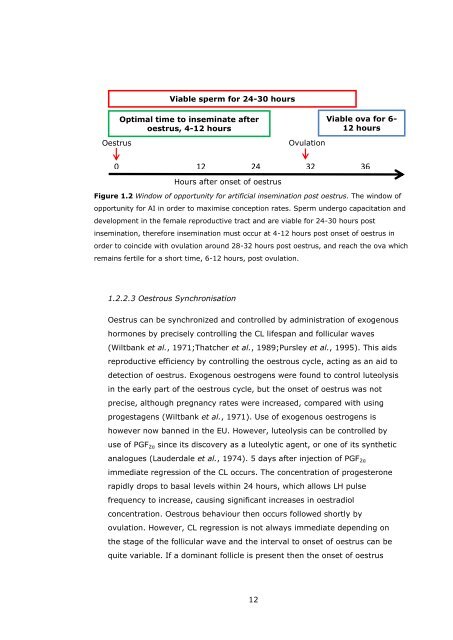novel approaches to expression and detection of oestrus in dairy cows
novel approaches to expression and detection of oestrus in dairy cows
novel approaches to expression and detection of oestrus in dairy cows
Create successful ePaper yourself
Turn your PDF publications into a flip-book with our unique Google optimized e-Paper software.
Viable sperm for 24-30 hours<br />
Optimal time <strong>to</strong> <strong>in</strong>sem<strong>in</strong>ate after<br />
<strong>oestrus</strong>, 4-12 hours<br />
Viable ova for 6-<br />
12 hours<br />
Oestrus<br />
Ovulation<br />
0 12 24 32 36<br />
Hours after onset <strong>of</strong> <strong>oestrus</strong><br />
Figure 1.2 W<strong>in</strong>dow <strong>of</strong> opportunity for artificial <strong>in</strong>sem<strong>in</strong>ation post <strong>oestrus</strong>. The w<strong>in</strong>dow <strong>of</strong><br />
opportunity for AI <strong>in</strong> order <strong>to</strong> maximise conception rates. Sperm undergo capacitation <strong>and</strong><br />
development <strong>in</strong> the female reproductive tract <strong>and</strong> are viable for 24-30 hours post<br />
<strong>in</strong>sem<strong>in</strong>ation, therefore <strong>in</strong>sem<strong>in</strong>ation must occur at 4-12 hours post onset <strong>of</strong> <strong>oestrus</strong> <strong>in</strong><br />
order <strong>to</strong> co<strong>in</strong>cide with ovulation around 28-32 hours post <strong>oestrus</strong>, <strong>and</strong> reach the ova which<br />
rema<strong>in</strong>s fertile for a short time, 6-12 hours, post ovulation.<br />
1.2.2.3 Oestrous Synchronisation<br />
Oestrus can be synchronized <strong>and</strong> controlled by adm<strong>in</strong>istration <strong>of</strong> exogenous<br />
hormones by precisely controll<strong>in</strong>g the CL lifespan <strong>and</strong> follicular waves<br />
(Wiltbank et al., 1971;Thatcher et al., 1989;Pursley et al., 1995). This aids<br />
reproductive efficiency by controll<strong>in</strong>g the oestrous cycle, act<strong>in</strong>g as an aid <strong>to</strong><br />
<strong>detection</strong> <strong>of</strong> <strong>oestrus</strong>. Exogenous oestrogens were found <strong>to</strong> control luteolysis<br />
<strong>in</strong> the early part <strong>of</strong> the oestrous cycle, but the onset <strong>of</strong> <strong>oestrus</strong> was not<br />
precise, although pregnancy rates were <strong>in</strong>creased, compared with us<strong>in</strong>g<br />
progestagens (Wiltbank et al., 1971). Use <strong>of</strong> exogenous oestrogens is<br />
however now banned <strong>in</strong> the EU. However, luteolysis can be controlled by<br />
use <strong>of</strong> PGF 2α s<strong>in</strong>ce its discovery as a luteolytic agent, or one <strong>of</strong> its synthetic<br />
analogues (Lauderdale et al., 1974). 5 days after <strong>in</strong>jection <strong>of</strong> PGF 2α<br />
immediate regression <strong>of</strong> the CL occurs. The concentration <strong>of</strong> progesterone<br />
rapidly drops <strong>to</strong> basal levels with<strong>in</strong> 24 hours, which allows LH pulse<br />
frequency <strong>to</strong> <strong>in</strong>crease, caus<strong>in</strong>g significant <strong>in</strong>creases <strong>in</strong> oestradiol<br />
concentration. Oestrous behaviour then occurs followed shortly by<br />
ovulation. However, CL regression is not always immediate depend<strong>in</strong>g on<br />
the stage <strong>of</strong> the follicular wave <strong>and</strong> the <strong>in</strong>terval <strong>to</strong> onset <strong>of</strong> <strong>oestrus</strong> can be<br />
quite variable. If a dom<strong>in</strong>ant follicle is present then the onset <strong>of</strong> <strong>oestrus</strong><br />
12
















